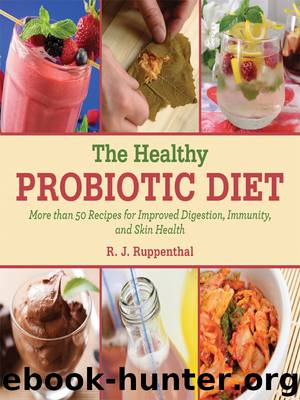The Healthy Probiotic Diet by R. J. Ruppenthal

Author:R. J. Ruppenthal
Language: eng
Format: epub
Publisher: Skyhorse Publishing
Published: 2013-12-14T16:00:00+00:00
Surprisingly, cheese may be one of the best probiotic foods in the world. Studies have demonstrated that because of cheese’s protein and fat complex, and the way our bodies digest this, cheese is extremely effective at delivering probiotic cultures deep into our digestive systems. With some other foods, the cultures are broken down in the stomach, so these cultures never have a chance to colonize in our guts. Apparently, cheese allows them to make it further down. Bottom line: eating probiotic cheese may be one of the best ways to rebuild and maintain your body’s probiotic health.
The recipes below cover cottage, feta, chevre (soft goat cheese), and gouda cheeses. They are probably the most difficult recipes in this book. I chose them both because of their probiotic benefits and because these are some of the simpler cheeses to make. Best of luck!
Cottage Cheese
Makes about 4 cups
Most cottage cheese recipes involve cooking the curds above 110°F, which does not help their probiotic content. This recipe uses a two-stage culturing process to create a live, active-cultured cottage cheese. First, mesophilic starter culture or buttermilk is used to separate the curd from the whey and create the proper flavor. After the curds are cut, drained, cooked, and drained again, yogurt whey or kefir adds a strong probiotic culture. Yes, you can use buttermilk as a source of culture for this cheese if you want, though the curd size will be smaller.
• 1 gallon milk (cow or goat milk)
• 1 package mesophilic direct-set cheese starter culture or ½ cup cultured buttermilk
• ½ rennet tablet (or ½ teaspoon liquid rennet), dissolved in ¼ cup water
• 2 tablespoons yogurt whey or kefir
• Optional: ½ teaspoon to 1 teaspoon sea salt
In a large pot, using a cheese thermometer, heat milk to 75°F. Add a culture packet or buttermilk, stir it in, and cover. The culture will take about 24 hours to do its job. During this time, its ideal temperature is 70–75°F, so try to insulate the pan if your air temperature is lower than this. Consider putting some warm water bottles around the pan and covering it with a towel or two, for example.
Download
This site does not store any files on its server. We only index and link to content provided by other sites. Please contact the content providers to delete copyright contents if any and email us, we'll remove relevant links or contents immediately.
The Bone Broth Miracle: How an Ancient Remedy Can Improve Health, Fight Aging, and Boost Beauty by Ariane Resnick(16450)
How to Be a Bawse: A Guide to Conquering Life by Lilly Singh(7162)
The Fat Loss Plan by Joe Wicks(4629)
The Ultimate Bodybuilding Cookbook by Kendall Lou Schmidt(3713)
A Jewish Baker's Pastry Secrets: Recipes from a New York Baking Legend for Strudel, Stollen, Danishes, Puff Pastry, and More by George Greenstein(3453)
The French Women Don't Get Fat Cookbook by Mireille Guiliano(3418)
Better Homes and Gardens New Cookbook by Better Homes & Gardens(3373)
Super Food Family Classics by Jamie Oliver(3250)
Dinner in an Instant by Melissa Clark(3003)
Bread Revolution by Peter Reinhart(2992)
Tom Kerridge's Dopamine Diet: My low-carb, stay-happy way to lose weight by Kerridge Tom(2954)
Body Love by Kelly LeVeque(2908)
Ottolenghi - The Cookbook by Yotam Ottolenghi(2740)
Flavor Flours by Alice Medrich(2648)
The Fat Chance Cookbook by Robert H. Lustig(2644)
Tone Your Tummy Type by Denise Austin(2638)
Oh She Glows Every Day by Angela Liddon(2634)
LL Cool J's Platinum 360 Diet and Lifestyle by LL Cool J(2587)
The Kitchen Counter Cooking School by Kathleen Flinn(2399)
